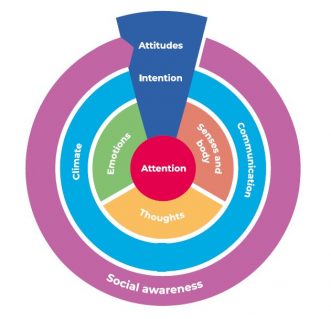Program
Presence in Education is a theoretical, experiential and scientifically proven program based on neuroscience, mindfulness and compassion, meant to facilitate and strengthen educational skills.
Our program focuses on how are institutions being inhabitated, helping educators to cultivate well-being through self-awareness, emotional regulations, prosocial behaviors and also promoting collaborative interventions for the institutionl well-being either.
Educators’ well-being is crucial.
Educators with socioemotional resources are better positioned to promote safe learning environments.
This is why we encourage members of the education community to adopt this program. Presence in Education is the key to create a new way to think, feel and deliver education for a life of fulfillment.
How is it implemented?
A team of facilitators and tutors guide the experiential learning process through synchronous and asynchronous online meetings and autonomous work.
Training is 100% online: two hour meetings with theoretical and practical material, including an integrated assessment.
The program provides the following teaching resources: reading modules, videographic material, bibliography, tutorials plus a resource kit for experiential learning.
RESOURCES KIT
Over a 100 experiential practices essential not only for individual transformation, but for the collective institutional work as well.
We work on each dimension of human experience: sensations, the body, thoughts, emotions and meta consciousness.
Contents
Based on scientific evidence, self-knowledge and he practice of experiential exercises are promoted to cultivate one’s own well-being, that of others and the planet.
Various contemplative practices are offered to promote self-awareness and states of greater well-being. This results in a better appropriation of the skills, competencies and attitudes that are intended to be cultivated.
This Program is centered in a powerful matrix that shows how to cultivate presence.

The matrix is a scheme containing and integrating our being and our relationship with the world. It includes our body, sensations, emotions and thoughts. All these and the way we pay attention to each component, are the gears that build the ability to be present.
The Program is divided into 8 modules.
Present with attention
It beckons us to understand and experience the way our brain builds and predicts our own reality.
The purpose is to cultivate the ability to train attention and comprehend the meaning of neuroplasticity as processes that lie behind learning and transformation.
Present with the senses and body
An invitation to develop the ability to be present with our body and senses through experience, becoming aware of the impact that conscious presence has in our physical, emotional and cognitive dimensions. We get to understand the relation between neuroplasticity, attention and learning. Through formal and informal practices we will experience emotional regulation as well.
Present with thoughts
It is a key to identify, observe and relate to thoughts. The mind gives meaning to our life by creating stories that appear willingly or not, as thoughts. The mind is wonderful. Relating assertively to it makes a big difference in our life.
Present with emotions
An invitation to analyze together what is understood by emotions and identify their function so that when an emotion arises, we can handle it resourcefully.
Present with discomfort
It is important to recognize the power of mindfulness to manage discomfort. This helps us experience the 3 emotional regulation system, going deeply into the threat system and its relation with stress. Focus is placed on the importance of a safe and reliable learning relationships and integral well-being, exploring acceptance, emotional validation and compassion as abilities to deal with discomfort.
Present with attitude
Here we explore the 9 attitudes suggested by John Kabat Zinn to unfold them in our daily life and understand the importance of a pause to connect with astonishment, silence, our relation with nature and our shared humanity. We also explore and work on attitudes, values and necessary actions leading to a greater well-being.
Atmosphere and communication
An invitation to make explicit the emotional influence of our professional practice in the institutional climate and in the learning process and to acquire strategies for intervention. Discover ways of assertive communication to promote a safe environment. Recognize the value of collaborative work and then build learning communities.
Collective intelligence for well-being
It seeks to strengthen the learning processes and develop collective intelligence applied to innovative projects with a positive result in the school community.